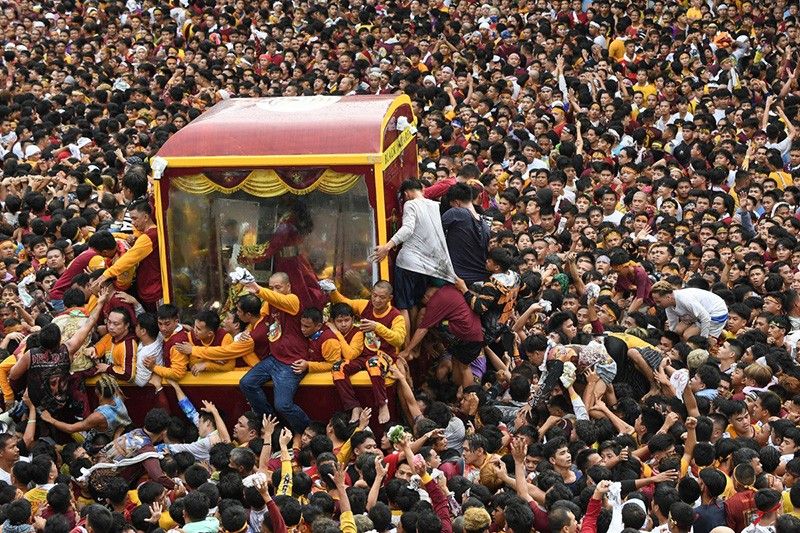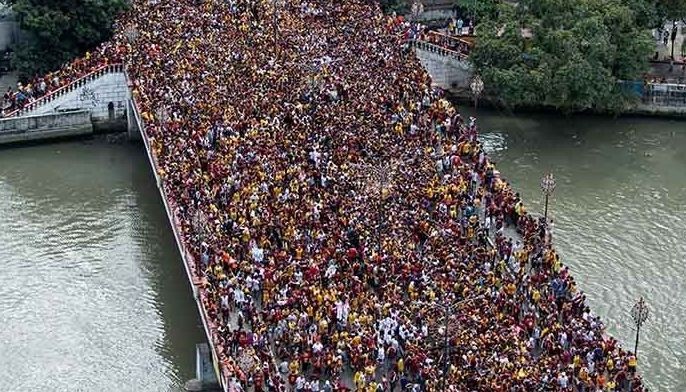What is Traslacion? Feast of the Black Nazarene explained

MANILA, Philippines — 2024 marked the physical return of the Traslación, four years since it was last held before the COVID-19 pandemic shut down Manila and the rest of the Philippines, as six million people walked the streets of the nation's capital.
The nation's capital celebrates every January 9 the Feast of the Black Nazarene, and the highlight of the celebrations is the hours-long mass procession popularly known as Traslación, the Spanish word for "transfer."
The activity commemorates the transfer of the Black Nazarene, a 17th century image of Jesus Christ carrying His cross, from the Church of San Juan Bautista in Bagumbayan (modern-day Luneta) to its new home, the Quiapo Church.
The original Black Nazarene statue was created by an unknown Mexican sculptor, brought to the Philippines, and enshrined in Bagumbayan on May 31, 1606.
Priest and Theologian Sabino Vengco claimed that the Black Nazarene is really dark and was not darkened or charred by fire because the image is made of mesquite wood, a type of wood native to North Americas, which was popularly used by early Spaniards to build ships.
Two years later, the Black Nazarene was enshrined in San Nicolas de Tolentino in Intramuros, a much bigger church of the Augustinian Recollect priests, before it was transferred on Jan. 9, 1787 to the Quiapo Church — its formal name the St. John the Baptist Church.
The statue is believed by devotees to be miraculous and is even more celebrated than Quiapo's patron saint St. John the Baptist every June 24, which also happens to be Manila Day.
Adding to its miraculous beliefs is the statue surviving earthquakes in 1645 and 1863, fires in 1791 and 1929, the 1945 bombing of Manila during World War II, and a number of floods.
Related: Catholics swarm Black Nazarene in feverish parade
It should be noted though that the actual liturgical commemoration of the Black Nazarene is during Good Friday.
Pahalik, Traslación
A few days before the procession, the image of the Black Nazarene is placed in Quirino Grandstand where devotees line up for hours to kiss it, hence the "pahalik" tradition.
Some devotees also take the opportunity to wipe cloth on the image, believing it can absorb the image's miraculous powers. The act is also done during the procession proper.
Thousands of devotees, often barefoot and wearing maroon and yellow like the image, then join the hours-long procession from the Grandstand to Quiapo Church.
The image is placed in an Ándas with several bearers called Mamámasán pulling, and yellow-and-white-clad Hijos directing the Ándas and protecting the image from damage.
This year, the image is sealed in glass, and devotees are prevented from climbing on to the Ándas, which has often been the case in past processions, delaying the walk further.
Related: At Traslacion, faithful urged: Live as models of Christ
Devotees can continue to throw their cloths or handkerchiefs at the Hijos, who will wipe them on a portion of the image's cross, which has been left open by glass.
Records
The 2012 Traslación remains the longest procession as it took 22 hours to arrive at Plaza Miranda, this as one of the Ándas' wheels broke early in the procession and the rope pulling the Ándas broke as the image was near the Liwasang Bonifacio.
Meanwhile, the fastest was the most recent iteration of the Traslación in 2020, which only took 16-and-a-half hours to complete.
That Traslación saw 22 million devotees commemorating the event, counting devotees who began the novena on December 31 and participated in the Pahalik.
In 2019, around four million devotees joined the Traslación proper.
There was no Traslación held from 2021 to 2023 because of the pandemic. Instead, the Quiapo Church held hourly masses and held a special viewing of the image.
In 2022, due to a spike in COVID-19 cases the masses were held behind closed doors while in 2023, an alternative procession called the "Walk of Faith" was conducted.
Today, the Feast of the Black Nazarene and the Traslación are regarded as among the world's biggest displays of religious devotion, attracting millions annually.
RELATED: LIST: Route of the Black Nazarene for Traslacion 2025






















